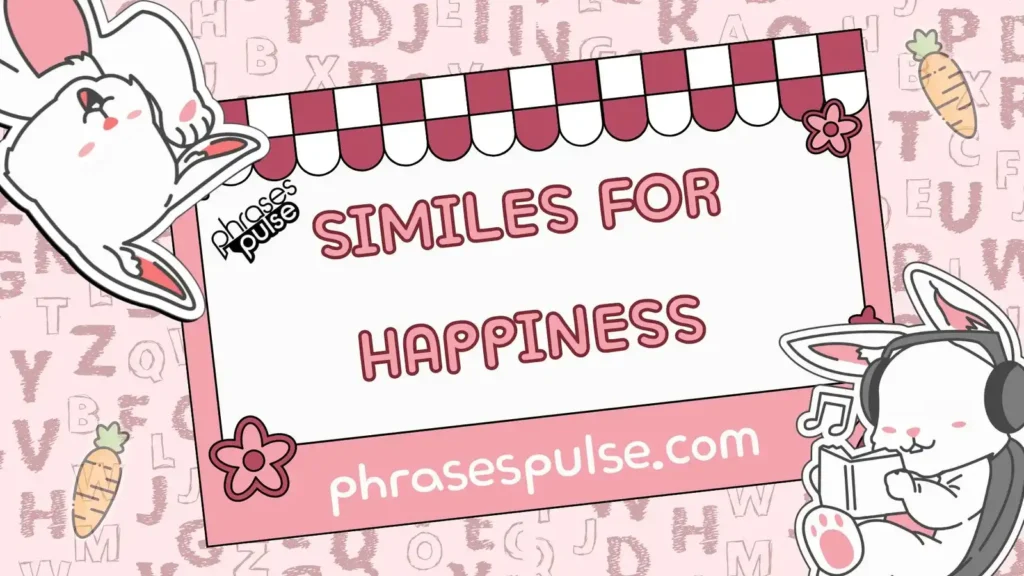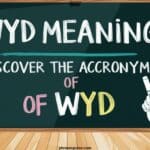Happiness is a universal feeling, yet it can be challenging to express in words. This is where similes for happiness come into play. In this article, we’ll explore 35 unique similes for happiness,
providing creative and vivid comparisons. Along the way, we’ll dive into why these expressions matter, how to use them effectively in writing, and the broader role of similes in language.
What Is a Simile for Happiness?
A simile is a figure of speech that compares two unlike things using the words “like” or “as.” When it comes to happiness, similes evoke images that capture the joy we feel in everyday moments.
Instead of saying, “I feel happy,” you might say, “I’m as happy as a dog with a new bone.” This comparison immediately creates a vivid mental image, helping readers or listeners feel the depth of your emotion.
Importance of Similes in Language
Similes, especially happiness similes, help us relate emotions in a way that’s easy to understand. They offer a linguistic adventure, turning abstract feelings into concrete images.
These creative comparisons create connections between different ideas, helping us explore the vast emotional landscape of joy and contentment.
35 Unique Similes for Happiness
Animal-Inspired Similes

Animals have long been a source of inspiration for describing emotions, and similes for happiness are no exception.
Whether it’s the playfulness of a dog or the freedom of a bird, these similes provide lively, joyful comparisons.
| Simile | Explanation |
|---|---|
| As happy as a dog with a new bone | Describes sheer excitement and satisfaction, like a dog enjoying its favorite treat. |
| Like a cat in the sun | Evokes the image of a relaxed, content cat basking in warmth. |
| Happy as a frog in a pond | Symbolizes pure, natural joy in a comfortable environment. |
| As happy as a monkey with a banana | Captures the fun, playful energy associated with excitement. |
| Like a dolphin leaping in the waves | Reflects freedom, playfulness, and the open joy of being in one’s element. |
| Happy as a horse in a meadow | Illustrates peaceful, carefree happiness, much like a horse roaming freely. |
| Like a parrot in the rainforest | Suggests vibrant, energetic joy, akin to a parrot surrounded by nature. |
| As happy as an elephant in a waterhole | Represents contentment and pleasure in a refreshing environment. |
These animal-inspired similes provide a way to compare happiness to the lively, carefree moments animals experience in their natural habitats.
Nature-Based Similes
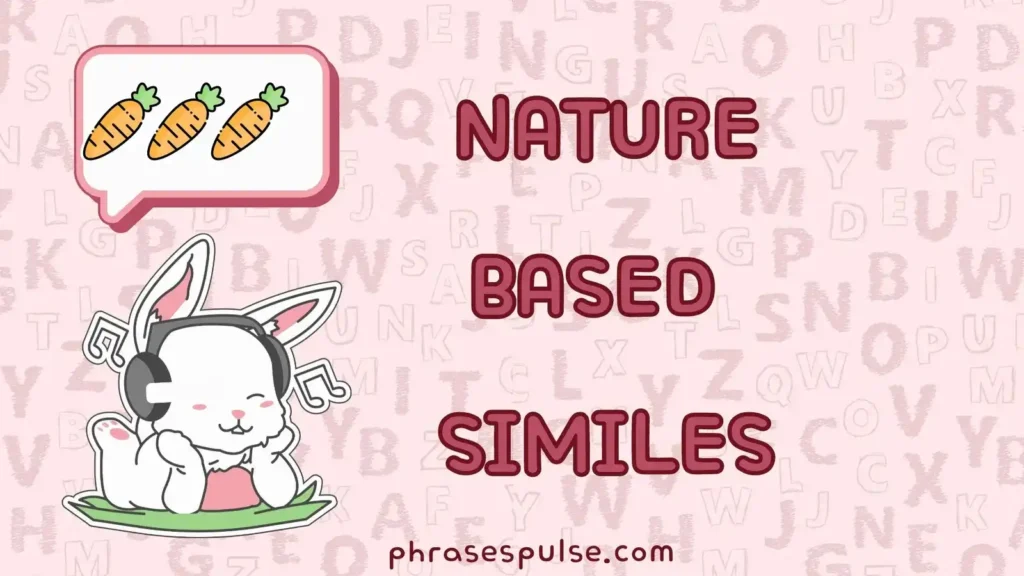
Nature often embodies the essence of joy and contentment. These similes connect happiness to the beauty and calmness of the natural world, providing peaceful, serene comparisons.
| Simile | Explanation |
|---|---|
| As happy as a flower in bloom | Captures the joy of growth and flourishing. |
| Like a tree basking in sunlight | Suggests warmth and contentment. |
| Happy as a river flowing freely | Represents unhindered joy and forward momentum. |
| Like a cloud floating in the sky | Conveys a sense of lightness and carefreeness. |
| As happy as a butterfly in a garden | Evokes the delicate, free joy of exploration and beauty. |
| Like a leaf dancing in the breeze | Illustrates effortless, natural happiness. |
| Happy as a bee in a field of lavender | Symbolizes busyness combined with satisfaction and enjoyment. |
| Like a rainbow after a storm | Suggests relief and the return of brightness after a difficult time. |
These joyful similes draw on the imagery of nature to express a sense of peace and radiant happiness.
Childhood/Youth-Inspired Similes
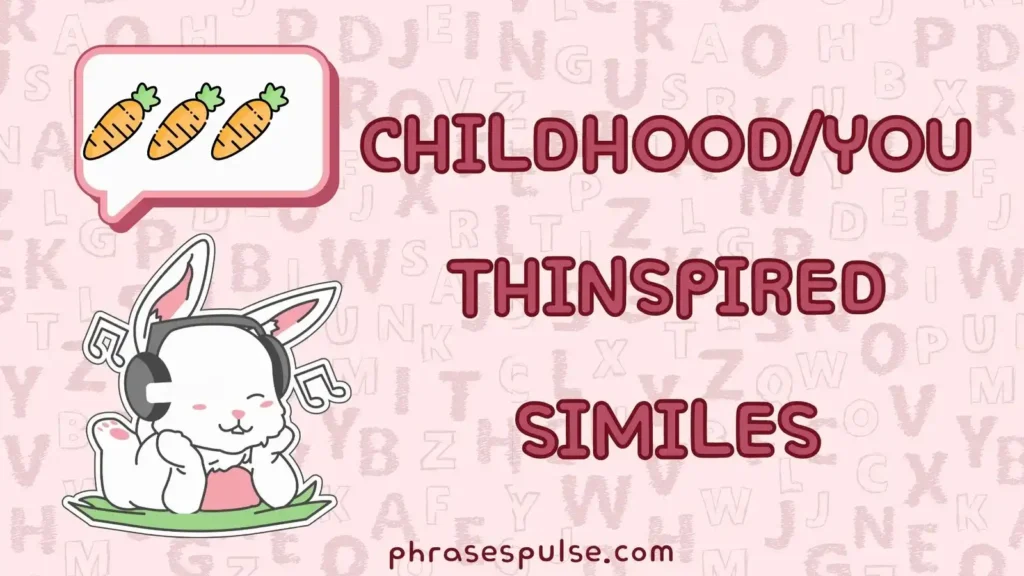
The innocence and excitement of childhood are perfect metaphors for happiness. These similes capture that sense of pure unbridled joy that often defines the happiest moments of our younger years.
| Simile | Explanation |
|---|---|
| As happy as a kid on a snow day | Reflects unexpected joy and the excitement of a surprise break. |
| Like a child with a new toy | Represents immediate, tangible joy. |
| Happy as a teen at their first concert | Captures the thrill and excitement of a new experience. |
| Like a kid in a candy store | Suggests overwhelming happiness, with many choices to enjoy. |
| As happy as a child at a birthday party | Evokes a sense of celebration and carefree enjoyment. |
Joyful art and childhood experiences often bring up a sense of nostalgia, which helps these similes resonate with a wide audience.
Everyday Joys Similes
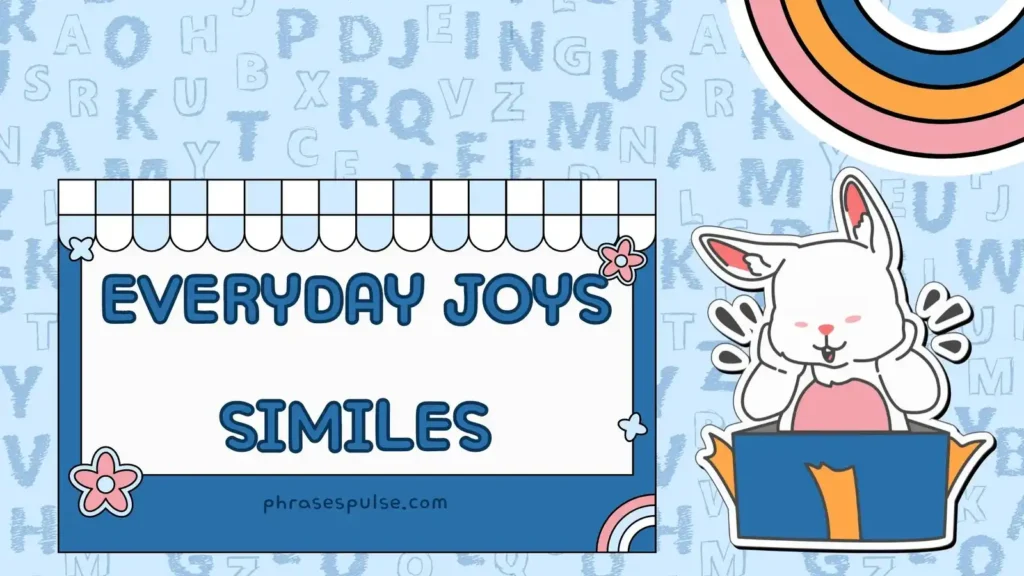
These similes take everyday experiences and elevate them into moments of unrestrained happiness. They are relatable and perfect for conveying familiar feelings of contentment.
| Simile | Explanation |
|---|---|
| As happy as a coffee lover with a fresh cup | Captures the comfort and satisfaction of a familiar routine. |
| Like a reader in a cozy chair | Suggests peaceful, quiet happiness in a moment of solitude. |
| Happy as someone finding forgotten cash in their pocket | Reflects unexpected delight. |
| Like a chef nailing the perfect recipe | Represents the joy of success and creativity. |
| As happy as a traveler finding a hidden gem | Conveys the satisfaction of discovery and exploration. |
These cheerful imagery examples are simple, yet they speak to the everyday moments of joy we can all relate to.
Event-Based Similes
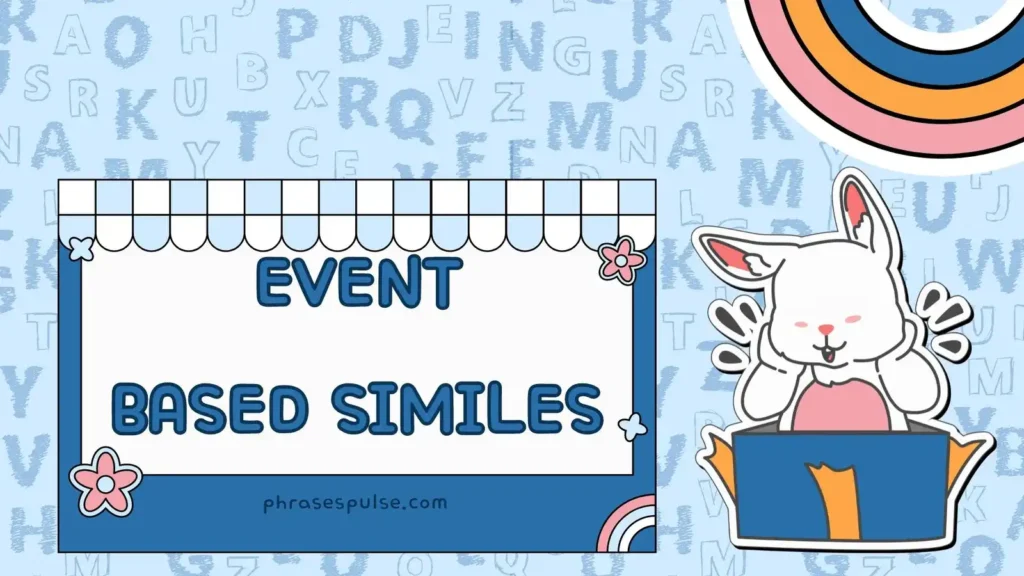
Big life events often come with big emotions. These similes focus on the joy that accompanies important milestones or achievements.
| Simile | Explanation |
|---|---|
| As happy as a graduate on graduation day | Reflects the culmination of hard work and the joy of achievement. |
| Like a bride on her wedding day | Represents a moment of ultimate happiness and celebration. |
| Happy as a sports fan after a victory | Captures the excitement and communal joy of winning. |
| Like a performer after a standing ovation | Suggests the exhilaration of success and approval. |
These figurative language comparisons help us understand the intensity of joy during significant life events.
Whimsical/Creative Similes
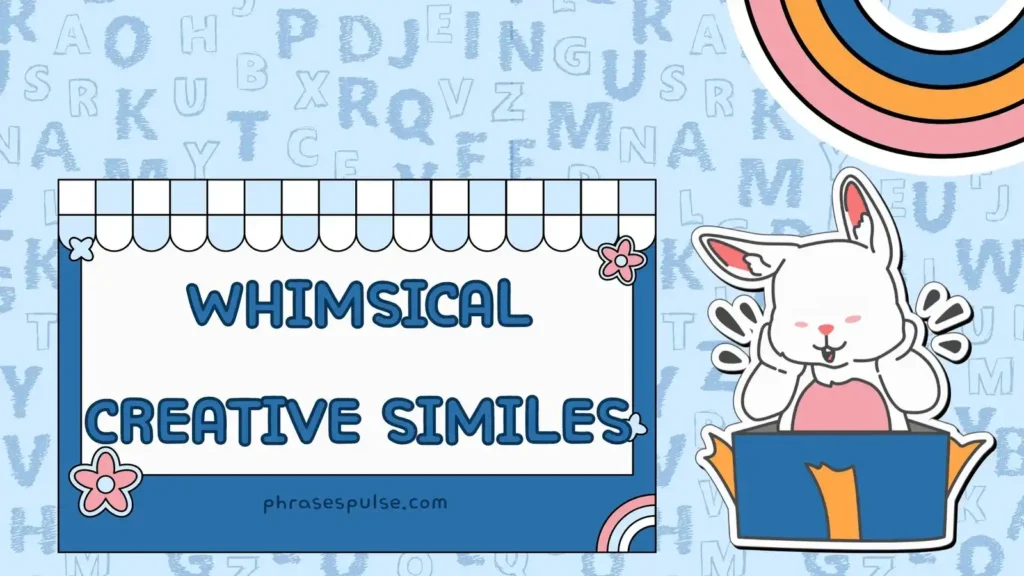
Finally, we arrive at some of the more imaginative happiness similes. These comparisons are playful, unexpected, and provide fresh ways to describe joy.
| Simile | Explanation |
|---|---|
| As happy as a kite in the wind | Represents freedom and the joy of soaring high. |
| Like a songbird at sunrise | Suggests the happiness of new beginnings and lightness. |
| Happy as a firework on the Fourth of July | Captures explosive, bright happiness. |
| Like a star twinkling in the night sky | Reflects peaceful joy that shines in the darkness. |
| As happy as a balloon floating freely | Evokes a sense of lightness and freedom, unburdened by worries. |
These joy with creative comparisons offer fresh and unique ways to express happiness in writing.
Why Similes for Happiness Matter
Similes are not just linguistic flourishes—they serve a deeper purpose in how we communicate emotion. Here’s why they matter, especially when describing joy and contentment:
Emotional Connection
Similes allow readers to feel the emotions described. By comparing happiness to something familiar, the reader can relate more deeply. This creates an immediate emotional connection, which is crucial for engaging storytelling.
Cultural Significance
Many idioms for happiness have deep cultural roots. For instance, the phrase “happy as a clam” comes from the idea that clams, when safe in their shells, are protected and content. Understanding these origins can add depth to your writing and help readers from different backgrounds connect to the language.
Psychological Impact
Happiness and language are closely intertwined. Research shows that using positive metaphors and similes can actually influence our mood. So when you describe yourself as “happy as a butterfly in a garden,” you might feel lighter and more joyful just by visualizing that image.
Creative Ways to Use Similes for Happiness in Writing
Similes can enrich your writing, but only if used thoughtfully. Here are some tips to incorporate figurative language and joyful metaphors naturally:
- Context Matters: Use similes that fit the tone of yourpiece. For example, if you’re writing a children’s story, “as happy as a kid in a candy store” might resonate better than a more sophisticated simile.
- Avoid Overuse: Similes are powerful, but too many can overwhelm your readers. Choose carefully and make sure each simile adds something new.
- Write from Experience: Think about personal moments of happiness and how they felt. Were you “happy as a kite in the wind” during a particular adventure? Drawing from real life adds authenticity.
Quiz: Test Your Simile Knowledge!
Now that we’ve explored some of the most joyful similes, how well can you remember them? Take this quiz to test your knowledge of happiness similes.
- Which simile involves an animal leaping joyfully?
- a) As happy as a monkey with a banana
- b) Like a dolphin leaping in the waves
- c) Happy as a butterfly in a garden
- Which simile captures the feeling of warmth and relaxation?
- a) Like a cat in the sun
- b) As happy as a frog in a pond
- c) Like a leaf dancing in the breeze
- What simile would best describe unexpected joy?
- a) As happy as a traveler finding a hidden gem
- b) Like a performer after a standing ovation
- c) Happy as a bee in a field of lavender
Conclusion
Similes for happiness offer a wealth of opportunities to express radiant happiness, pure unbridled joy, and joyful satisfaction. They enrich our language and help us capture the essence of our emotions, making our writing more vivid, relatable, and powerful.
Whether you’re as happy as a butterfly in a garden or like a songbird at sunrise, similes provide endless possibilities to explore the joyful side of life.

Ava Rose, the creator of PhrasesPulse, is an expert in English grammar with years of experience. She is dedicated to simplifying complex grammar rules and exploring the richness of English phrases. Through her insightful posts, Ava aims to help learners of all levels enhance their understanding of the language and communicate more effectively. Her passion is making grammar approachable and enjoyable for everyone.

